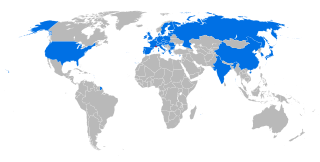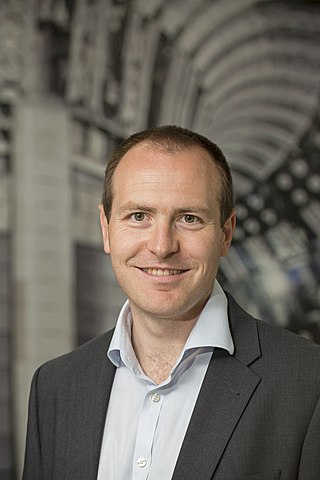
A tokamak is a device which uses a powerful magnetic field to confine plasma in the shape of a torus. The tokamak is one of several types of magnetic confinement devices being developed to produce controlled thermonuclear fusion power. As of 2016, it was the leading candidate for a practical fusion reactor. The word "tokamak" is derived from a Russian acronym meaning "toroidal chamber with magnetic coils".

Princeton Plasma Physics Laboratory (PPPL) is a United States Department of Energy national laboratory for plasma physics and nuclear fusion science. Its primary mission is research into and development of fusion as an energy source. It is known for the development of the stellarator and tokamak designs, along with numerous fundamental advances in plasma physics and the exploration of many other plasma confinement concepts.

Fusion power is a proposed form of power generation that would generate electricity by using heat from nuclear fusion reactions. In a fusion process, two lighter atomic nuclei combine to form a heavier nucleus, while releasing energy. Devices designed to harness this energy are known as fusion reactors. Research into fusion reactors began in the 1940s, but as of 2024, no device has reached net power.

ITER is an international nuclear fusion research and engineering megaproject aimed at creating energy through a fusion process similar to that of the Sun. Upon completion of construction of the main reactor and first plasma, planned for late 2025, it will be the world's largest magnetic confinement plasma physics experiment and the largest experimental tokamak nuclear fusion reactor. It is being built next to the Cadarache facility in southern France. ITER will be the largest of more than 100 fusion reactors built since the 1950s, with ten times the plasma volume of any other tokamak operating today.
JT-60 is a large research tokamak, the flagship of Japan's magnetic fusion program, previously run by the Japan Atomic Energy Research Institute (JAERI) and later by the Japan Atomic Energy Agency's (JAEA) Naka Fusion Institute in Naka, Ibaraki Prefecture. As of 2023 the device is known as JT-60SA and it is the largest operational superconducting tokamak in the world to date, and was built and is operated jointly by the European Union and Japan. SA stands for super advanced tokamak, including a D-shaped plasma cross-section, superconducting coils, and active feedback control.

Magnetic confinement fusion (MCF) is an approach to generate thermonuclear fusion power that uses magnetic fields to confine fusion fuel in the form of a plasma. Magnetic confinement is one of two major branches of controlled fusion research, along with inertial confinement fusion.

DEMO refers to a proposed class of nuclear fusion experimental reactors that are intended to demonstrate the net production of electric power from nuclear fusion. Most of the ITER partners have plans for their own DEMO-class reactors. With the possible exception of the EU and Japan, there are no plans for international collaboration as there was with ITER.

The Experimental Advanced Superconducting Tokamak (EAST), internal designation HT-7U, is an experimental superconducting tokamak magnetic fusion energy reactor in Hefei, China. The Hefei Institutes of Physical Science is conducting the experiment for the Chinese Academy of Sciences. It has operated since 2006.

The Institute for Plasma Research (IPR) is an autonomous physics research institute in India. The institute conducts research in plasma science, including basic plasma physics, research on magnetically confined hot plasmas, and plasma technologies for industrial applications. It is a leading plasma physics organization. The institute is mainly funded by the Department of Atomic Energy. IPR plays a major scientific and technical role in Indian partnership in the international fusion energy initiative ITER. It is part of the IndiGO consortium for research on gravitational waves.

The Plasma Science and Fusion Center (PSFC) at the Massachusetts Institute of Technology (MIT) is a university research center for the study of plasmas, fusion science and technology.
General Fusion is a Canadian company based in Vancouver, British Columbia, which is developing a fusion power device based on magnetized target fusion (MTF). The company was founded in 2002 by Dr. Michel Laberge. The company has more than 150 employees in three countries, with additional centers co-located with fusion research laboratories near London, and Oak Ridge, Tennessee, US.
Pucadyil Ittoop John is an Indian plasma physicist. He occupies the Meghnad Saha Chair in Plasma Science and Technology at the Institute for Plasma Research, Ahmedabad.
ADITYA is a medium size tokamak installed at the Institute for Plasma Research in India. Its construction began in 1982, and it was commissioned in 1989. It was the first tokamak in India.
SST-1 is a plasma confinement experimental device in the Institute for Plasma Research (IPR), an autonomous research institute under Department of Atomic Energy, India. It belongs to a new generation of tokamaks with the major objective being steady state operation of an advanced configuration plasma. It has been designed as a medium-sized tokamak with superconducting magnets.

Sir Steven Charles Cowley is a British theoretical physicist and international authority on nuclear fusion and astrophysical plasmas. He has served as director of the United States Department of Energy (DOE) Princeton Plasma Physics Laboratory (PPPL) since 1 July 2018. Previously he served as president of Corpus Christi College, Oxford, since October 2016. and head of the EURATOM / CCFE Fusion Association and chief executive officer of the United Kingdom Atomic Energy Authority (UKAEA).
Tihiro Ohkawa was a Japanese physicist whose field of work was in plasma physics and fusion power. He was a pioneer in developing ways to generate electricity by nuclear fusion when he worked at General Atomics. Ohkawa died September 27, 2014, in La Jolla, California, at the age of 86.

Sir Ian Trevelyan ChapmanFRS is a British physicist who is the chief executive of the United Kingdom Atomic Energy Authority (UKAEA).
Tokamak Energy is a fusion power company based near Oxford in the United Kingdom, established in 2009. The company is pursuing the global deployment of commercial fusion energy in the 2030s through the combined development of spherical tokamaks with high temperature superconducting (HTS) magnets. It is also developing HTS magnet technology for other applications.

Ambrogio Fasoli is a researcher and professor working in the field of fusion and plasma physics. A Fellow of the American Physical Society, he is Director of the Swiss Plasma Center, located at EPFL, the Swiss Federal Institute of Technology in Lausanne, Switzerland. Since 1 January 2019, he chairs the European consortium EUROfusion, the umbrella organisation for the development of nuclear fusion power in Europe.











